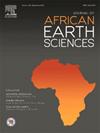Mapping flood hazard in Driouch region (north-eastern of Morocco) using AHP and numerical approaches
IF 2.2
4区 地球科学
Q2 GEOSCIENCES, MULTIDISCIPLINARY
引用次数: 0
Abstract
Driouch City situated in the northeastern of Morocco, has been historically prone to flooding due to its geomorphological and anthropogenic factors. The main objective of this study is to conduct a comparative analysis of the flood hazard in this region using two different approaches. The first approach combined GIS with the multi-criteria decision analysis AHP to create flood hazard maps, using nine static key parameters, which are elevation, slope, flow accumulation, distance from the river, drainage density, runoff, land use, Topographical Wetness Index (TWI), and Normalized Difference Vegetation Index (NDVI). Then, weights are assigned to these factors based on their impact on flooding in the Driouch City. The results indicate that the distance from the river significantly affect areas surrounding the mainstream of Kert basin and its two tributaries. The next step involves comparing the AHP-GIS results with the outputs from the numerical method commonly used as a validation approach for static methods. In this study, it consists of conducting a hydraulic simulation using Iber, a 2D model based on the Saint-Venant equations for flood area distribution. The key input parameters of the simulation are Digital Elevation Model (DEM), land use, runoff and rainfall data. The post-process of the simulation shows how water depths and velocities are distributed along the rivers, noting the high vulnerability to flooding of Oued Kert and Oued Hammam with values exceeding 1m and 1m/s, respectively. By overlaying these two parameters using the GIS, the second flood hazard map is obtained. The comparison of the two resulting maps shows a clear similarity for areas classified as having higher-order flood hazards, which confirms the findings of each other and correlating with historical data; AHP classifying and weighting flood causative factors, and Iber modeling the behavior of the flood. This study concludes the importance of considering the two approaches to assess flood hazards. Most vulnerable areas to sudden floods are residential areas in this case, requiring the redevelopment of watercourses and hydraulic structures and developing a risk prevention plan.
利用层次分析法和数值方法绘制Driouch地区(摩洛哥东北部)的洪水灾害图
德里乌赫市位于摩洛哥东北部,由于其地貌和人为因素,历史上一直容易发生洪水。本研究的主要目的是使用两种不同的方法对该地区的洪水灾害进行比较分析。第一种方法将GIS与多准则决策分析AHP相结合,使用9个静态关键参数(高程、坡度、流量累积、与河流的距离、排水密度、径流、土地利用、地形湿度指数(TWI)和归一化植被指数(NDVI))创建洪水灾害图。然后,根据这些因素对德里乌奇市洪水的影响,为这些因素分配权重。结果表明,离河距离对克尔特流域干流及其两条支流周边地区影响显著。下一步是将AHP-GIS结果与通常用作静态方法验证方法的数值方法的输出进行比较。在本研究中,使用基于Saint-Venant方程的洪水面积分布二维模型Iber进行水力模拟。模拟的关键输入参数是数字高程模型(DEM)、土地利用、径流和降雨数据。模拟的后期处理显示了水深和流速沿河流的分布情况,注意到Oued Kert和Oued Hammam的高度易受洪水影响,其值分别超过1m和1m/s。利用GIS将这两个参数叠加,得到第二次洪水灾害图。两幅结果图的比较表明,高阶洪涝灾害区域具有明显的相似性,这证实了彼此的发现,并与历史数据相关联;采用层次分析法对洪水成因进行分类和加权,建立洪水行为模型。本研究总结了考虑这两种方法来评估洪水灾害的重要性。在这种情况下,最容易受到突发洪水影响的地区是居民区,这需要重新开发水道和水利结构,并制定风险预防计划。
本文章由计算机程序翻译,如有差异,请以英文原文为准。
求助全文
约1分钟内获得全文
求助全文
来源期刊

Journal of African Earth Sciences
地学-地球科学综合
CiteScore
4.70
自引率
4.30%
发文量
240
审稿时长
12 months
期刊介绍:
The Journal of African Earth Sciences sees itself as the prime geological journal for all aspects of the Earth Sciences about the African plate. Papers dealing with peripheral areas are welcome if they demonstrate a tight link with Africa.
The Journal publishes high quality, peer-reviewed scientific papers. It is devoted primarily to research papers but short communications relating to new developments of broad interest, reviews and book reviews will also be considered. Papers must have international appeal and should present work of more regional than local significance and dealing with well identified and justified scientific questions. Specialised technical papers, analytical or exploration reports must be avoided. Papers on applied geology should preferably be linked to such core disciplines and must be addressed to a more general geoscientific audience.
 求助内容:
求助内容: 应助结果提醒方式:
应助结果提醒方式:


